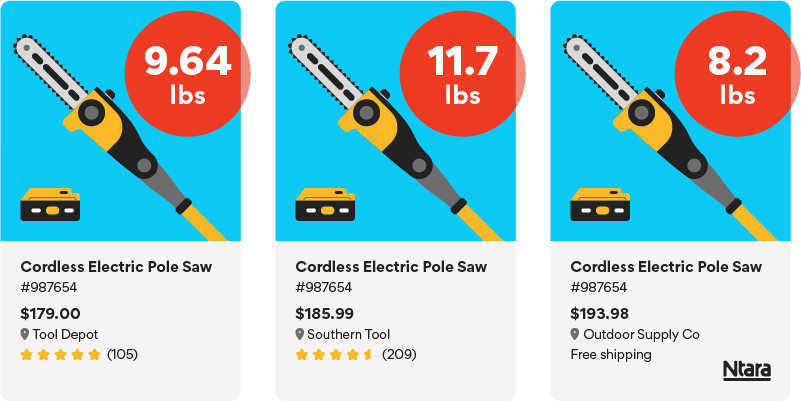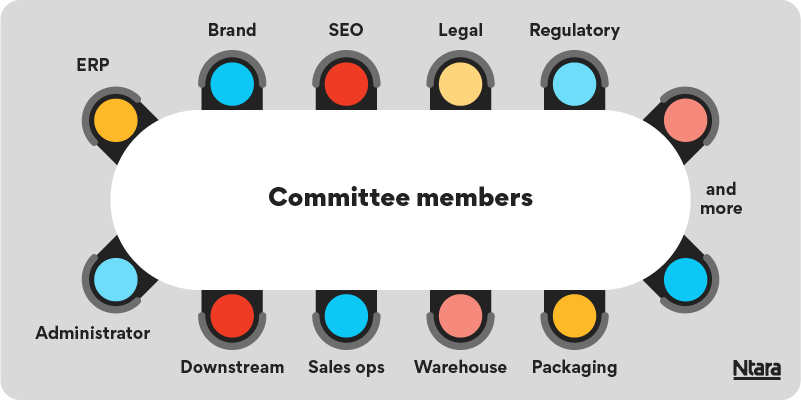“A place for everything and everything in its place.” – Benjamin Franklin (maybe).
We’ve all heard this saying, and it is typically attributed to the oft-quoted founding father. However, it’s also possible that the idiom has a nautical context, which makes sense given the tight quarters and lack of storage on most ships.
No matter who said it, the sentiment is a good one. It implies that when your house is in order, everything runs more smoothly. That goes for your home—and your product data.
Example: Why product data governance matters
When you’re shopping for a tool online, most likely you’ll read (or at least skim) the overview of a product description. Then you may review the specifications list. Among other details, the specs usually include the product’s dimensions: length, width, height, and weight.
Say you’re a consumer in need of a cordless pole saw. While you’re shopping around, you focus on the weight of the tool because the lighter it is, the easier it will be to use—especially over long periods of time. Just a few ounces’ difference one way or another can determine how sore your shoulders will be the day or two after a big landscaping project.
Now imagine you’ve found a pole saw you like, and the website tells you it weighs 9.64 lbs. You’re fine with that, but you want to shop around and see if you can find the tool on another site for a better price. When you do, you notice that on that site, the weight of the pole saw is 11.7 lbs. That’s a bit heavier than you wanted, so you go to yet another site. There, the pole saw is listed at 8.2 lbs.

At this point, you’re probably wondering why the number is so different from site to site—and you may even be questioning your trust in the brand. If they can’t ensure consistency in something as “simple” as their product listings, can you rely upon their product to live up to its reputation?
Looking at the situation from a consumer’s viewpoint, it’s easy to see why details like the weight of a product should be consistent across the board. However, as a leader in your business, you know that product data consistency can be a complicated process.
What you need is a standardized process for product data governance.
What does “product data governance” mean?
Unfortunately, there is no set-it-and-forget-it solution. Ongoing maintenance in the form of product data governance is required to avoid situations like the pole saw example above.
A good product information management (PIM) platform centralizes your product data and data practices. Ongoing product data governance makes sure it stays that way.
More than just a one-time project, product data governance is an ongoing process that makes your product data clean, consistent, and coherent—and keeps it that way for the long term.
And for better or worse, making that happen requires another C-word: committee.
What does a product data governance committee do?
Like many other areas of business, considering various perspectives gives you a better overall view of the challenge you’re facing. When you’re assembling a product data governance committee, you’ll want to think about who in your organization touches product data and why. Each of those employees has different thoughts about the same piece of data based upon his or her role.
For example, someone from your warehouse team may think your pole saw should be weighed with the battery included, but someone from your PIM team may disagree. A product data governance committee takes everyone’s opinion into account—and makes the smartest decisions for the business as a whole.
When a question arises regarding a data point, the committee will ask questions like:
- Does this data already exist somewhere else? If so, where?
- Is this core data or ancillary data?
- Does this data belong in a PIM or in another system?
- What system is the controller in the data input?
- How are we tracking attributes?
Once these questions are answered and everyone on the committee has had a say, they can determine whether data needs to be changed/added or not. The committee can also put in place rules that outline which data points get generated within what system, who is responsible for inputting the data, what the rules are for that data (e.g., decimal numbers vs. integers), and more. With governance processes in place, team members throughout the business know how they should request new data attributes moving forward.
In short, a product data governance committee defines the data management system, ensures everyone sticks to it, and adjusts the system as needed. It also detects when data fields are combined and should be separated and enforces formatting rules. In other words, the committee keeps data consistent no matter where it shows up.
Assembling a product data governance committee
In a perfect world, you would put a product data governance committee in place at the same time as you implement your PIM. But if you didn’t, don’t despair—it’s never too late.
First, you need a “sponsor” in the c-suite who recognizes the importance of clean data and will put stakeholders from throughout the company into positions of governance.

For most businesses, committee members should include:
- Someone from ERP, brand, SEO, legal, and regulatory
- Someone who administers PIM
- Someone familiar with your downstream system needs (e.g., Amazon)
- Someone from sales operations
- Someone from the warehouse
- Someone from packaging
- And more, depending on your product types or business model
You need the healthy tension of a cross-functional team that will evaluate your product data from multiple points of view. The committee may not have a member from every single branch of the business, but it needs someone from the key branches that play a role in product data.
For example, the accounting department may not necessarily need a representative from that department on the committee, but someone on the committee should have a good understanding of pricing. The legal department may not need someone on the committee, as long as they are brought in when their approval is required. Your product data governance committee may grow or constrict over time to accommodate your business needs.
Business value of product data governance
The value of a product data governance committee will show almost immediately. Say your business objective is to increase your online revenue by 25% next year. To be successful, your ecommerce team needs good, clean data—not just in the beginning of the project, but during and after as well. Product data governance ensures cleaner product data.
Here’s a good way to determine how clean and consistent your product data is: Pick five products. See how each product appears across five ecomm channels. (To do this at scale, use a tool like inriver Evaluate).
Does the product data make sense? Does it tell the same story across all channels?
If not, you need to standardize your internal data, how you deliver that product data downstream, and your customer experience—no matter where they shop for your products. The best way to do this is to put together a well-balanced product data governance committee.